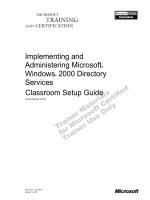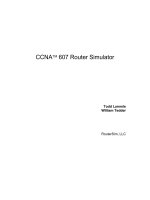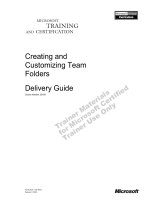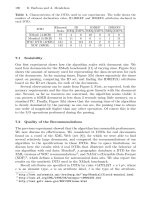Tài liệu Overview and Objectives pptx
Bạn đang xem bản rút gọn của tài liệu. Xem và tải ngay bản đầy đủ của tài liệu tại đây (565.32 KB, 12 trang )
Case Study
Routing
Cisco Networking Academy Program
CCNA 2: Routers and Routing Basics v3.0
Overview and Objectives
This case study allows students to complete a network design, implementation,
and troubleshooting project using the skills gained in CCNA 2. Students will use
the skills that have already been developed to use, make, and connect the proper
cabling to the appropriate devices.
It is crucial to read and understand the scenarios to make sure that all
requirements are fulfilled. Each scenario guides the student through the proper
steps to ensure that the project is completed properly.
This case study requires the student to accomplish the following tasks:
■ Set up the physical layout of the network using the diagram and
accompanying narrative
■ Correctly configure the routers with a basic router configuration
■ Set up a TFTP server on one of the workstations
■ Create and apply access control lists on the appropriate router(s) and
interface(s)
■ Troubleshoot and test all connectivity and access control lists
■ Provide detailed documentation in a prescribed form, as listed in the
deliverables section
2 - 12 CCNA 2: Routers and Routing Basics v3.0 Copyright 2003, Cisco Systems, Inc.
Scenario and Phase 1: Project Description
A company has several people responsible for maintaining various sections of
the internetwork infrastructure. Many technicians have done an excellent job
with the small portion for which they are responsible.
One of the other network associates who was responsible for a larger portion of
the infrastructure suddenly left the company. This left redesign and
implementation on this portion of the internetwork unfinished. A technician is
given the task to complete the design and implementation of the unfinished
network.
After taking home the documentation to study over the weekend, it is apparent to
the technician why the network associate left suddenly. The few documents that
existed were poorly written. So during the weekend the technician reconstructs
the diagram above from an existing diagram that was found. It represents the new
internetwork design. It shows the planned routers, hubs/switches, circuits, and
the servers/workstations at each site. The server at the Center site is a file server
accessed only by workstations on this internetwork. The workstation at the
Center site is used to manage all routers on the internetwork.
After returning to work Monday morning, the technician presents the new
diagram to the Network Infrastructure Team Leader that assigned the project.
After discussion, it is determined that new documentation must be developed for
the project. The Team Leader, the instructor, must approve the documentation at
each phase of the process. Use the following information to implement the
network.
Network address ___________________________
Required number of subnets __________________
Routing protocol ___________________________
Copyright 2003, Cisco Systems, Inc. Case Study: Routing 3 - 12
Phase 2: IP Addressing
Now that the basic plan is in place, the team leader assigns the technician to
develop a prototype for the new internetwork. Use the network address assigned
along with the subnetting requirements, to subnet the network. From the IP
addressing scheme, assign IP addresses to the appropriate interfaces on all routers
and computers in the internetwork. Use the diagram below as a guide. Obtain
approval of this phase of development from the team leader before proceeding to
Phase 3.
Instructor approval ___________________Date __________________
Network Diagram - IP Addressing
4 - 12 CCNA 2: Routers and Routing Basics v3.0 Copyright 2003, Cisco Systems, Inc.
Phase 3: Basic Router and Workstation
Configuration
After the team leader inspects the prototype cabling, the technician is assigned to
create a basic configuration on the router and workstations.
Use the diagram and planning sheets to create a basic configuration for the
router. The checklist below will help keep track of the configuration process.
Boaz Center Eva
Hostname
Console Password
Secret Password
VTY Password
Serial 0/0 IP address
Serial 0/1 IP address
*Serial 0/0 Clock Rate
*Serial 0/1 Clock Rate
Fa 0/0 IP address
Fa 0/1 IP address
Enable the interfaces
Add Routing Protocol
Add Network
Statements
Note *: As needed
Table continued on next page
Copyright 2003, Cisco Systems, Inc. Case Study: Routing 5 - 12
Boaz Center Eva
* Host Table - contains
all routers and servers
Message of the Day
Serial 0/0 description
Serial 0/1 description
Fa 0/0 description
Fa 0/1 description
Instructor approval _____________________Date __________________
6 - 12 CCNA 2: Routers and Routing Basics v3.0 Copyright 2003, Cisco Systems, Inc.
Phase 4: Access Control Lists
While testing the network, the team leader discovers that security has not been
planned for the network. If the network configuration were installed as designed,
any network user would be able to access all network devices and workstations.
The team leader asks the technician to add access control lists (ACLs) to the
routers. The team leader has some suggestions for developing the security.
Before the ACLs are added, backup the current router configuration. Also, make
sure there is complete connectivity throughout the network before any of the
ACLs are applied.
The following conditions must be taken into consideration when creating the
ACLs:
■ Workstation 2 and File Server 1 are on the management network. Any
device on the management network can access any other device on the entire
network.
■ Workstations on Eva and Boaz LANs are not permitted outside of their
subnet except to access File Server 1.
■ Each router can telnet to the other routers and access any device on the
network.
The team lead asks the technician to write down a short summary of the purpose
of each ACL, the interfaces upon which they will be applied, and the direction of
the traffic. Then list the exact commands that will be used to create and apply the
ACLs to the router interfaces.
Before the ACLs are configured on the routers, review each of the following test
conditions and make sure that the ACLs will perform as expected:
Telnet from Boaz to Eva SUCCESSFUL
Telnet from Workstation 4 to Eva BLOCKED
TELNET from Workstation 5 to Boaz BLOCKED
TELNET from Workstation 2 to Boaz SUCCESSFUL
TELNET from Workstation 2 to Boaz SUCCESSFUL
Ping from Workstation 5 to File Server 1 SUCCESSFUL
Ping from Workstation 3 to File Server 1 SUCCESSFUL
Ping from Workstation 3 to Workstation 4 SUCCESSFUL
Ping from Workstation 5 to Workstation 6 SUCCESSFUL
Ping from Workstation 3 to Workstation 5 BLOCKED
Ping from Workstation 2 to Workstation 5 SUCCESSFUL
Ping from Workstation 2 to Workstation 3 SUCCESSFUL
Ping from Router Eva to Workstation 3 SUCCESSFUL
Ping from Router Boaz to Workstation 5 SUCCESSFUL
Copyright 2003, Cisco Systems, Inc. Case Study: Routing 7 - 12
Phase 5: Documenting the Network
In order to support the network properly, documentation is required. Create
documentation that is logically organized to make troubleshooting simpler.
Configuration Management Documentation
Boaz Center Eva
show cdp neighbors
show ip route
show ip protocol
show ip interface brief
show version
show hosts
show startup config
Security Management Documentation
Boaz Center Eva
show ip interface
show ip access lists
Instructor approval ___________________Date __________________
8 - 12 CCNA 2: Routers and Routing Basics v3.0 Copyright 2003, Cisco Systems, Inc.
Case Study Deliverables
The key lesson of this case study is the importance of thorough and clear
documentation. There should be two types of documentation completed.
General Documentation:
■ A complete narrative of the project should be typed using word processing
software. Since the scenarios break up the entire task into pieces, take care
to address each scenario task so that any layperson could understand that
particular task.
■ Microsoft Excel or another spreadsheet program could be used to simply list
the equipment and serial numbers.
■ Cisco Network Designer (CND), Microsoft Visio, or any paint program
could be used to draw the network.
■ Provide documentation that specifies how the security was tested. A plan for
monitoring the network should also be included.
Technical Documentation:
The technical documentation should include details of the network topology.
Use CND, Visio, or any paint program to draw the network.
Use the tables in the working copy of the case study as a reference, and enter all
table information into a spreadsheet program such as Microsoft Excel. The
spreadsheet should include the following details:
• IP addressing of all interfaces
• DCE/DTE information
• Router passwords
• Interface descriptions
• IP addressing and gateway assignments for all PCs
The actual access control lists, or router commands sequence, should be included
in this documentation using a word processing program, Be sure to include the
router interface the list is applied to and the direction.
Document the use of a routing protocol.
Router output from the following commands should be captured and placed into
this documentation:
■ show cdp neighbors
■ show ip route
■ show ip protocol
■ show ip interface
■ show version
■ show hosts
Copyright 2003, Cisco Systems, Inc. Case Study: Routing 9 - 12
■ show startup-config
■ show ip access-list
10 - 12 CCNA 2: Routers and Routing Basics v3.0 Copyright 2003, Cisco Systems, Inc.
Instructor Notes
Phase 1: Project Description
This phase of the case study can begin early in the semester, as students should
be familiar with subnetting.
The entire case study should be discussed in class so that all students understand
that the purpose of this study is not only to practice configuration and
troubleshooting, but also to learn how to document their work. The following
are some good web sites that will help the students’ understanding of
documentation:
/>
/>
/>
/>
The network address assigned should be one of the private IP address ranges or a
subnet of one:
Class Range
A 10.0.0.0 – 10.255.255.255
B 172.16.0.0 – 172.31.255.255
C 192.168.0.0 – 192.168.255.255
The routing protocol should be IGRP. The first part of Phase 1 should probably
be completed as a class so that students understand the purpose of the case study.
Along with a discussion of Phase 1, the deliverable piece should also be covered.
The instructor should decide whether or not this is a group project. Certainly
each student should be capable of deciding on IP addresses of interfaces after the
IP scheme has been chosen.
The Network Diagram - IP Addressing on page 4 is the first document that
should be approved by the instructor.
Phase 2: IP Addressing
This Phase of the case study should be due after module 4 or 5 is completed.
Students should recreate the drawing during this Phase using CDN, Visio, or a
paint program. In the drawing the students should be advised to insert the
appropriate interface connections on the routers. The drawing should be
approved by the instructor.
The following topics can be used for class discussion:
• The reasons for using private IP addressing
Copyright 2003, Cisco Systems, Inc. Case Study: Routing 11 - 12
• The concept of reserved address space for routers, servers, and hosts
• The reasons for developing an IP address scheme to allow for future
growth
Phase 3: Basic Router and Workstation Configuration
This Phase should be completed after students feel comfortable with basic router
configuration, sometime after Module 7.
Students should be somewhat familiar with router configuration, and understand
the basic requirements. The checklist included in Phase 3 will help them to
include the essential items for router configuration. The student should select
which workstation is to be the TFTP server. They must understand which devices
need access to the TFTP server. Students should be guided to complete the chart
in Phase 3, and then have the instructor approve the configuration.
After instructor approval, students should enter their configurations and test them
on the routers.
Phase 4: Access Control Lists
This Phase should be completed after Module 11.
This is a most critical portion of the case study. Students must develop an access
control list on paper first, then type the ACL into a word processing application.
The instructor should guide the students through the process of copying and
pasting ACLs into the router configuration.
Phase 5: Documenting the Network
If the documentation requirements are clear to the students at the beginning of
the case study, the final Phase will have been completed throughout the life of
the case study. The Phase will help to reiterate the purpose of documentation,
that it should be done continually and revisited, not only once.
During the last phase the deliverables list should be discussed again to make sure
the student understands the requirements.
Optional
An additional Phase could be a reflection phase so that the student can look
objectively at this case study. Questions might include: “Why have two types of
documentation?”, “What happens when a piece of equipment fails?”, and so
forth.
12 - 12 CCNA 2: Routers and Routing Basics v3.0 Copyright 2003, Cisco Systems, Inc.









